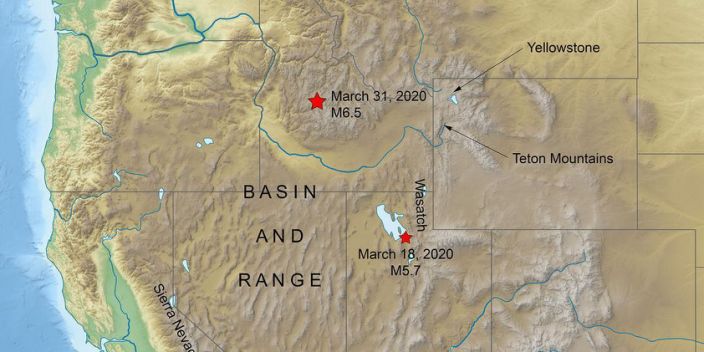Months after a magnitude 6.5 earthquake struck Idaho, the southern part of the state is still shaking.
And scientists have no clues why…

On March 31, a M6.5 earthquake hit Idaho‘s Sawtooth mountain range, northeast of Boise. It was the second largest earthquake to strike Idaho, with the strongest shaking being 1983’s M6.9 Borah Peak earthquake.
But the region hasn’t stopped shaking since. The area has experienced a string of aftershocks in the months following the quake, some registering as high as magnitude 4.8.
The shaking has been so strong, in fact, that a popular beach along Stanley Lake in the Sawtooth National Recreation Area has sunk into the water.
“The most probable cause for the ‘disappearing’ of the inlet delta is a combination of liquefaction and compaction of saturated sediments and some possible sliding and later spreading on the delta toward the deeper part of the lake,” said Claudio Berti, director and state geologist of the Idaho Geological Survey.
Stanley Lake Inlet Beach Collapses a result of the March 31 Earthquake @SawtoothNatlFS pic.twitter.com/bF8sm2sCK7
— Sawtooth NF (@SawtoothNatlFS) May 9, 2020
Sawtooth Fault
The March 31 earthquake occurred 16 miles north of the Sawtooth Fault, a 40-mile stretch of fault line discovered nearly a decade ago. Geologists have largely believed the fault was inactive, but the latest round of quakes have reinvigorated interest in the region.
Geologists are puzzling over exactly what caused an earthquake in the otherwise quiet region. Some researchers suspect the Sawtooth Fault is actually longer than expected. Others believe the fault is now taking advantage of openings in Earth’s crust and is slowly pushing north. One theory suggests energy from the Sawtooth Fault could have jumped to a nearby unknown fault, spurring the recent series of earthquakes.
For now, the race is on to collect more data about the region, so that geologists can paint a clearer picture of what’s happening below surface. In addition to gathering seismic readings and analyzing soil samples, researchers will use LIDAR to hunt for signs of movement in the area.
What’s with all the shaking?
In the aftermath of a major earthquake, it’s common for a series of smaller earthquakes, called aftershocks, to occur.
Aftershocks, which usually originate on the same fault line, can last for days, weeks, months and even years following the main shock. The larger the earthquake, the longer it’ll take the fault to get all that shaking out of its system.
Waves from the #IdahoEarthquake rolling through Alaska and the lower 48. Data from the @IRIS_EPO Data Management Center. Thanks guys for making it so easy to access seismic data! pic.twitter.com/M7aGex1zyV
— UMN Seismology (@UMNseismology) April 1, 2020
In some cases, seismic energy along a fault line will build up over a long time. A 2009 paper in the journal Nature suggested earthquakes that occur far away from tectonic plate boundaries may be lingering aftershocks from temblors that happened centuries earlier. The pace at which two tectonic plates slide past each other could dictate how long aftershocks may last, with slower movement leading to longer last bursts of related seismic activity.
Scientists are currently working on ways to use artificial intelligence to forecast where aftershocks may occur. A team of researchers used 131,000 reported earthquakes to train a neural network to accurately forecast aftershocks, according to a 2018 paper published in Nature.
Idaho has a history of bigger quakes. In 1983, the Borah Peak quake was M7.0. Today's quake is almost 100 miles northwest of the 1983 event.
— Dr. Lucy Jones (@DrLucyJones) April 1, 2020
Earthquake risks along the Sawtooth Fault
Idaho lies along the northern edge of a geologically active region called the Basin and Range Province. This region, which spans eastern California to Utah and down into Sonora, Mexico, has been stretched taught over the past 20 million years, creating a series of wide valleys and vast mountain ranges. It’s also chock full of old seismic faults—just like the one that sprang to life on March 31.
In 2010, geologists found that the 40 miles (64 km) long Sawtooth Fault that runs near Stanley, Idaho and Redfish Lake could produce an earthquake measuring up to M7.5.
Moreover, they discovered that two past large earthquakes likely took place on the fault around 7,000 and 4,000 years ago.
Even though Idaho is still rumbling, that doesn’t mean Yellowstone is headed for an eruption. No, it means a Big Quake is able to hit and destroy your home anytime. So be ready and get prepared!
More earthquake news on Strange Sounds and Steve Quayle. Now if you are looking for supplements to increase your healthy lifestyle and sexlife please visit Natural Health Source. [Idaho Statesman, Popular Mechanics]












The Big One is coming, and it will obliterate the entire american continent. Millions will die.